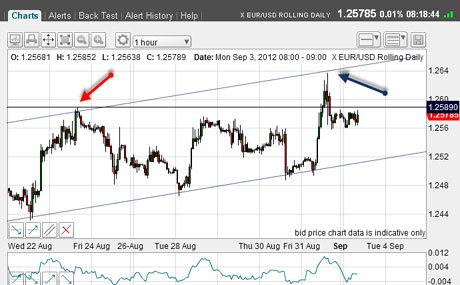Another great tramline test for the euro
John C Burford looks at another trade in the euro which demonstrates the power the tramline trading system gives traders.
Today is Labor Day in the USA and markets there are closed, except for the Globex markets. Normally on US public holidays, trading is very muted, but we shall see.
On Friday, I showed my tramlinetrio that I believed was operating on the hourly chart. At that time, the market was testing my centre tramline. And with Friday's explosive action later in the day, it rallied to test my upper tramline.
This was another gift for those wishing to short the euro, as I will show.
MoneyWeek
Subscribe to MoneyWeek today and get your first six magazine issues absolutely FREE

Sign up to Money Morning
Don't miss the latest investment and personal finances news, market analysis, plus money-saving tips with our free twice-daily newsletter
Don't miss the latest investment and personal finances news, market analysis, plus money-saving tips with our free twice-daily newsletter
So let's see how this tramline fared as resistance.
Here is this morning's chart:

(Click on the chart for a larger version)
The upper line is my uppermost tramline. The horizontal line is the Fibonacci 38% retrace of the big wave down from the February 1.35 major high, down to the July low that I showed on Friday.
As I noted then, the market rallied to my highest tramline (red arrow), then fell back, and was testing the centre tramline as I wrote.
But in the afternoon, we had a certain Mr Bernanke make another vague pronouncement from on high and the floodgates opened, especially in the stock market and gold (which I hope to cover this week).
But note exactly how far the rally carried. Yes to an exact turn at my tramline (blue arrow).
How is that for precision? And a gift for short-sellers.
For newcomers, just take a moment to consider the power the tramline system gives a trader. Last week, I drew in these tramlines. Extending these lines into the future gives precise areas where I should expect support and resistance and probable turning points.
Turning points are the best places to enter trades
Making a short trade near the upper tramline gives you a low-risk short entry point. Why low risk? Simply because if the market breaks above the tramline, it shows the lines are no longer working (resistance has been overcome) and I want out! Placing a close stop just above the line gives you that litmus test.
Trading in between tramlines is a higher-risk proposition as stop placement is more problematical. It can be done, but you need to be aware of the higher risk.
I like to focus most of my trading around tramlines, and I would advise any trader starting out to do likewise.
A long trade was indicated last Friday, as the market was lying on the centre tramline (support).
So, in one day, there was a possible winning long trade, and then a short trade.
Before I go, the market is testing the underside of the Fibonacci 38% line, having broken below it late on Friday.
It will be interesting to see if this line now resistance holds.
If you're a new reader, or need a reminder about some of the methods I refer to in my trades, then do have a look at my introductory videos:
The essentials of tramline trading
An introduction to Elliott wave theory
Advanced trading with Elliott waves
Don't miss my next trading insight. To receive all my spread betting blog posts by email, as soon as I've written them, just sign up here . If you have any queries regarding MoneyWeek Trader, please contact us here.
Get the latest financial news, insights and expert analysis from our award-winning MoneyWeek team, to help you understand what really matters when it comes to your finances.
John is is a British-born lapsed PhD physicist, who previously worked for Nasa on the Mars exploration team. He is a former commodity trading advisor with the US Commodities Futures Trading Commission, and worked in a boutique futures house in California in the 1980s.
He was a partner in one of the first futures newsletter advisory services, based in Washington DC, specialising in pork bellies and currencies. John is primarily a chart-reading trader, having cut his trading teeth in the days before PCs.
As well as his work in the financial world, he has launched, run and sold several 'real' businesses producing 'real' products.
-
 How cancelling unused direct debits could boost your pension by £37,000
How cancelling unused direct debits could boost your pension by £37,000A new year refresh of your spending could save you money and help boost your pension pot.
-
 NS&I cuts interest rates on 8 savings accounts
NS&I cuts interest rates on 8 savings accountsNS&I will now offer less attractive interest rates for customers wishing to lock their savings away to grow for one, two, three or five years.